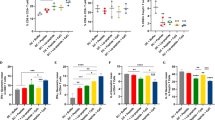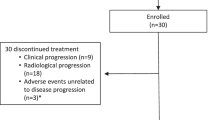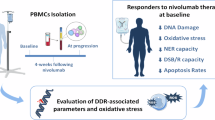Abstract
Aim:
DNAs containing unmethylated CpG motifs can stimulate innate and adaptive immunity. The aim of this study was to investigate the immunostimulatory and anti-neoplasm effects of a novel CpG oligodeoxynucleotide, ODN10, in tumor-bearing mice.
Methods:
B16 melanoma-bearing C57BL/6 mice were administered ip or sc with ODN10 or conventional CpG ODN1826 on the indicated days post inoculation. The animal survival rate and the inhibitory effect on tumor growth were observed in vivo. B and T lymphocyte proliferation, natural killing cell cytotoxicity and the phagocytic ability of peritoneal macrophages from the animals were determined using [3H]-thymidine incorporation assay, 4-h 51Cr release assay and neutral red chromometry method, respectively. The serum levels of IL-12, IL-4 and IgE were quantified using ELISA assays. Histological examination of tumor tissues was performed after HE staining, and the expression of PCNA, CD63, and CD80 in tumor tissues was analyzed with immunohistochemistry.
Results:
ODN10 (1, 5 and 25 mg/kg) significantly inhibited the growth and metastasis of the tumor, and significantly prolonged the survival of tumor-bearing mice, as compared with ODN1826. The immune status was suppressed in tumor-bearing mice. Both ODN10 and ODN1826 significantly reversed the suppressed immunoactivities in tumor-bearing mice, which included promoting B and T lymphocyte proliferation, enhancing NK cell and peritoneal macrophage activities, inducing IL-12 secretion and inhibiting IL-4 and IgE secretion. Further, CpG ODNs decreased PCNA and CD63 expression while induced expression of CD80. ODN10 presented more potent activity, and displayed the most prominent immunostimulatory potential.
Conclusion:
ODN10 produces prominent immunomodulatory effects on cellular immunity in tumor-bearing mice, which might help reverse the established Th2-type responses to the Th1-type responses, thus may be used as a potent anti-tumor immunotherapy agent or adjuvant.
Similar content being viewed by others
Log in or create a free account to read this content
Gain free access to this article, as well as selected content from this journal and more on nature.com
or
References
Yechiel B . Molecular immunological approaches to biotherapy of human cancers — A review, hypothesis and implications. Anticancer Res 2006; 26: 1113–34.
Hemmi H, Takeuchi O, Kawai T, Kaisho T, Sato S, Sanjo H, et al. A Toll-like receptor recognizes bacterial DNA. Nature 2000; 408: 740–5.
Krieg AM . CpG motifs in bacterial DNA and their immune effects. Annu Rev Immunol 2002; 20: 709–60.
Klinman DM . Immunotherapeutic uses of CpG oligodeoxynucleotides. Nat Rev Immunol 2004; 4: 249–58.
Latz E, Schoenemeyer A, Visintin A, Fitzgerald KA, Monks BG, Knetter CF, et al. TLR9 signals after translocating from the ER to CpG DNA in the lysosome. Nat Immunol 2004; 5: 190–8.
Verthelyi D, Klinman DM . Immunoregulatory activity of CpG oligonucleotides in humans and nonhuman primates. Clin Immunol 2003; 109: 64–71.
Marshall JD, Fearon K, Abbate C, Subramanian S, Yee P, Gregorio J, et al. Identification of a novel CpG DNA class and motif that optimally stimulate B cell and plasmacytoid dendritic cell functions. J Leukocyte Biol 2003; 73: 781–92.
Vollmer J, Weeratna R, Payette P, Jurk M, Schetter C, Laucht M, et al. Characterization of three CpG oligo-deoxynucleotide classes with distinct immunostimulatory activities. Eur J Immunol 2004; 34: 251–62.
Brunner C, Seiderer J, Schlamp A, Bidlingmaier M, Eigler A, Haimerl W, et al. Enhanced dendritic cell maturation of TNF-alpha or cytidine-phosphate-guanosine DNA drives T cell activation in vivo and therapeutic anti-tumor immune responses in vitro. J Immunol 2000; 165: 6278–86.
Ballas ZK, Krieg AM, Warren T, Rasmussen W, Davis HL, Waldschmidt M, et al. Divergent therapeutic and immunologic effects of oligo-deoxynucleotides with distinct CpG ODN motifs. J Immunol 2001; 167: 4878–86.
Wooldridge JE, Ballas ZK, Krieg AM, Weiner GJ . Immunostimulatory oligodeoxynucleotides containing CpG motifs enhance the efficacy of monoclonal antibody therapy of lymphoma. Blood 1997; 89: 2994–8.
van Ojik HH, Bevaart L, Dahle CE, Bakker A, Jansen MJH, van Vugt MJ, et al. CpG-A and B oligodeoxynucleotides enhance the efficacy of antibody therapy by activating different effector cell populations. Cancer Res 2003; 63: 5595–600.
Heckelsmiller K, Beck S, Rall K, Sipos B, Schlamp A, Tuma E, et al. Combined dendritic cell and CpG oligonucleotide-based immune therapy cures large murine tumors that resist chemotherapy. Eur J Immunol 2002; 32: 3235–45.
Davila E, Celis E . Repeated administration of cytosine-phosphorothiolated guanine-containing oligonucleotides together with peptide/protein immunization results in enhanced CTL responses with anti-tumor activity. J Immunol 2000; 165: 539–47.
Blazar BR, Krieg AM, Taylor PA . Synthetic unmethylated cytosine- phosphateguanosine oligodeoxynucleotides are potent stimulators of antileukemia responses in naive and bone marrow transplant recipients. Blood 2001; 98: 1217–25.
Sharma S, Karakousis CP, Takita H, Shin K, Brooks SP . Intra-tumoral injection of CpG results in the inhibition of tumor growth in murine Colon-26 and B-16 tumors. Biotechnol Lett 2003; 25: 149–53.
Carpentier AF, Chen L, Maltonti F, Delattre JY . Oligodeoxynucleotides containing CpG motifs can induce rejection of a neuroblastoma in mice. Cancer Res 1999; 59: 5429–32.
Carpentier AF, Xie J, Mokhtari K, Delattre JY . Successful treatment of intracranial gliomas in rat by oligodeoxynucleotides containing CpG motifs. Clin Cancer Res 2000; 6: 2469–73.
Baines J, Celis E . Immune-mediated tumor regression induced by CpG-containing oligodeoxynucleotides. Clin Cancer Res 2003; 9: 2693–700.
Buhtoiarov IV, Sonde PM, Eickhoff JC, Rakhmilevich AL . Macrophages are essential for antitumour effects against weakly immunogenic murine tumours induced by class B CpG-oligodeoxynucleotides. Immunology 2007; 120: 412–23.
Mason KA, Neal R, Hunter N, Ariga H, Ang K, Milas L . CpG oligo- deoxynucleotides are potent enhancers of radio- and chemoresponses of murine tumors. Radiother Oncol 2006; 80: 192–8.
Du HY, Xia SY, Song HF, Li N, Shang MM, Zou J, et al. Structure-efficacy relationships of immunostimulatory activity of CpG-containing oligodeoxynucleotides on mouse spleen cells. Acta Pharmacol Sin 2007; 28: 1637–44.
Walker PS, Scharton-Kersten T, Krieg AM, Love-Homan L, Rowton ED, Udey MC, et al. Immunostimulatory oligodeoxynucleotides promote protective immunity and provide systemic therapy for leishmaniasis via IL-12- and IFN-γ-dependent mechanisms. Proc Natl Acad Sci U S A 1999; 96: 6970–5.
Harandi AM, Eriksson K, Holmgren J . A protective role of locally administered immunostimulatory CpG oligodeoxynucleotide in a mouse model of genital herpes infection. J Virol 2003; 77: 953–62.
Gramzinski RA, Doolan DL, Sedegah M, Davis HL, Krieg AM, Hoffman SL . Interleukin-12- and gamma interferon-dependent protection against malaria conferred by CpG oligodeoxynucleotide in mice. Infect Immunol 2001; 69: 1643–9.
Blackwell SE, Krieg AM . CpG-A-induced monocyte IFN-gamma-inducible protein-10 production is regulated by plasmacytoid dendritic cell-derived IFN-alpha. J Immunol 2003; 170: 4061–8.
Ballas ZK, Rasmussen WL, Krieg AM . Induction of NK activity in murine and human cells by CpG motifs in oligodeoxynucleotides and bacterial DNA. J Immunol 1996; 157: 1840–5.
Shan BE, Hao JS, Li QX, Taqawa M . Antitumor activity and immune enhancement of murine interleukin-23 expressed in murine colon carcinoma cells. Cell Mol Immunol 2006; 3: 47–52.
Nie H, Meng LZ, Zhang H . Effects of accidental exposure to external cause of gingerol on endotoxemia mouse model induced by heatstroke. Zhongguo Zhong Xi Yi Jie He Za Zhi 2006; 26: 529–32.
Serebrisky D, Teper AA, Huang CK, Lee SY, Zhang TF, Schofield BH, et al. CpG oligodeoxynucleotides can reserae Th2-associated allergic airway responses and alter the B7.1/B7.2 expression in a murine model of asthma. J Immunol 2000; 165: 5906–12.
Kitagaki K, Jain VV, Businga TR, Hussain I, Kline JN . Immunomodulatory effects of CpG oligodeoxynucleotides on established Th2 responses. Clin Diagn Lab Immunol 2002; 9: 1260–9.
Acknowledgements
This work was supported by the National Natural Science Foundation of China (grant number 30572197) and the National High Biotechnology Development Program of China (grant number 2003AA2Z347B).
We gratefully acknowledge Prof Wen TAN (Cancer Institute & Hospital, Chinese Academy of Medical Sciences) for her excellent technical assistance.
Author information
Authors and Affiliations
Corresponding author
Rights and permissions
About this article
Cite this article
Du, Hy., Dong, Lh., Zhao, Bj. et al. Immunostimulatory and anti-neoplasm effects of a novel palindrome CpG oligodeoxynucleotide in mice. Acta Pharmacol Sin 33, 1047–1054 (2012). https://doi.org/10.1038/aps.2012.54
Received:
Accepted:
Published:
Issue date:
DOI: https://doi.org/10.1038/aps.2012.54



